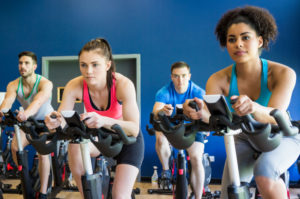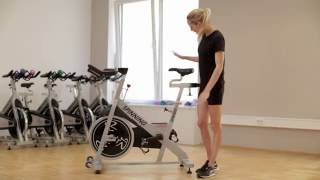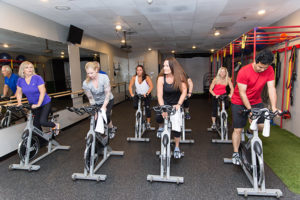Want to know what to expect or how to get the most from your Spinning® class? Here are the answers to frequently asked questions.
Getting Started
 I’ve never taken a Spinning class before. What should I expect?
I’ve never taken a Spinning class before. What should I expect?
Every class is a little different, but one of the great things about the Spinning program is that it is adaptable to your fitness level. Remember that there’s no competition. Listen to your body and adjust the resistance on your bike accordingly. If you’re a first timer, let your instructor know and they can make sure you bike is properly adjusted.
Do I have to be in great shape to participate in a Spinning class?
Anyone can benefit from the Spinning programme. And because you can go at your own pace by controlling the resistance on your Spinner® bike, taking Spinning classes is a great way to get fit and reach your fitness goals.
What makes Spinning class different from other group exercise classes?
Top-notch instructors, invigorating music and visualisation come together to make Spinning class both fun and effective. If you’ve ever left a group exercise class feeling frustrated, you’ll appreciate that there are no complicated moves to learn with the Spinning programme. Regardless of how fit, flexible or coordinated you are, you’ll get a great workout. Simply hop on your bike, set the resistance to the level that’s right for you, and let your instructor guide you through an incredible ride.
How many calories will I burn in a Spinning class, and what is the approximate equivalent distance in road miles travelled?
The number of calories you’ll burn depends on a number of factors, including your weight and the intensity at which you exercise. On average, participants burn about 400–600 calories in a 40-minute workout. The “distance” travelled depends on cadence; however as an estimate, an average 40-minute class at a cadence of 80–110 rpm is equivalent to approximately 15–20 miles on the road.
How is taking a Spinning class different than just riding a stationary bike?
Spinning class makes riding a stationary more bike fun by adding variety and visualisation into your workout. A motivating group setting, energising music and inspiring instructors make Spinning class an incredible experience.
What type of gear do I need to participate in a Spinning class?
Comfortable workout attire is all you need to get started. But the right gear can make a great class even better. Padded cycling short will make your ride more comfortable and a heart rate monitor will help you get the most from every workout.
Will taking Spinning classes make my legs bulk up?
The “climbs” that are incorporated into a Spinning class simulate the experience of riding up a hill. Climbing is an excellent way to build strength, which means you not only get shapelier legs but also stoke your metabolism since muscle needs more calories to sustain itself than fat does. However, most climbs only last a few minutes, which is not enough time to build big, bulky leg and butt muscles. If you’re ever in doubt, share your training goals with your instructor and ask them to help you create the ride that’s right for you.
During Class
 How can I get more comfortable sitting on the saddle?
How can I get more comfortable sitting on the saddle?
If you’re new to the Spinning programme it may take a few sessions for your body to get used to the saddle. Wearing padded cycling shorts or using a gel seat cover will definitely make your ride more comfortable.
Sometimes my toes go numb while I’m riding. How can I solve this problem?
The most common cause of numbness is restricted blood flow to the feet, which can be caused by shoes, shoelaces or toe straps that are too tight. Loosening laces and straps often solves the problem. If this doesn’t help, you may want to consider foam insoles or front-ended orthotics. They can provide relief by redistributing pressure on the ball of your foot.
How can cycling shoes help me in a Spinning class?
Cycling shoes are made with a very stiff sole that enables more powerful pedal strokes. Cycling shoes can also be used with clipless pedals, which facilitate a push/pull action and more efficient pedal strokes.
Why should I wear a heart rate monitor in Spinning class?
The Spinning programme consists of five Energy Zones. These Energy Zones vary in intensity and are based upon certain percentages of your maximum heart rate. By wearing a heart rate monitor, you will be better equipped to assess the intensity of your ride and determine when to push harder, maintain your pace or reduce your effort. By taking the guesswork out of your workout, you maximize your efficiency while minimising your odds of over-training, injury and burnout.
How do I calculate my maximum heart rate?
The best place to start is with the age predicted formula, which is calculated by subtracting your age from 220 if you are a male and from 226 if you’re a female. For example, if you’re a 30 year-old man, your Age Predicted Maximum Heart Rate would be 190.
Technique
 What’s the proper way to perform Jumps?
What’s the proper way to perform Jumps?
Jumps are an advanced move that develop strength and balance. Using Hand Position 2, transition in and out of the saddle with one smooth, controlled movement.
What’s the proper way to incorporate Sprints into my ride?
A Sprint is an advanced move in which riders go at an “all-out” pace for about 30 seconds.
Why is pedalling backward not recommended?
Pedalling backward is risky on a fixed gear bike. If riders try to quickly stop the flywheel while pedalling backward, the compressive forces on the knee joint can be sufficient enough to tear cartilage or the meniscus. Also, pedalling backward may hyperextend the legs, which could damage the ACL or other soft tissue of the knee joints. Aside from being risky, a further reason not to do it is that there is no physiological advantage to it. A study in the Strength and Conditioning Journal showed that muscle contribution and metabolic cost were the same for pedalling forward and backward. Lastly, this movement puts the bike at risk as well. Pedalling backward may eventually unscrew the pedals from the crank arm.